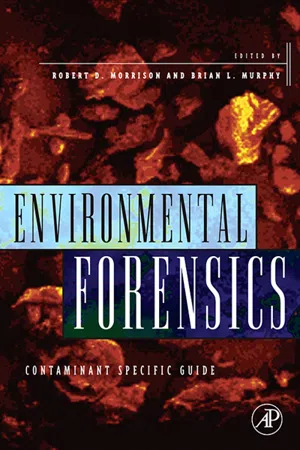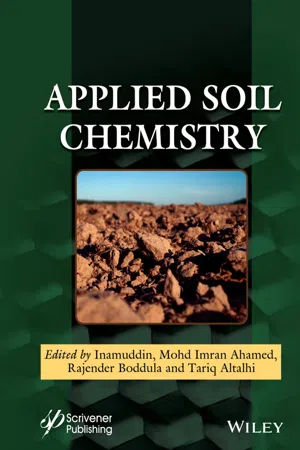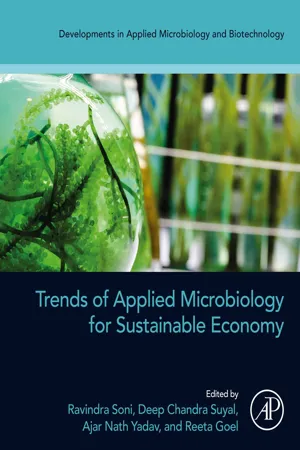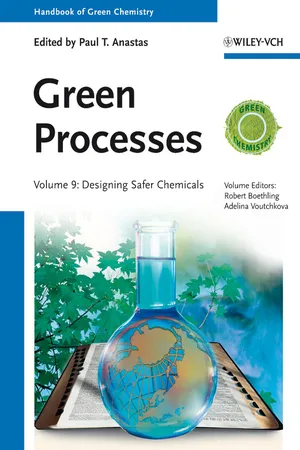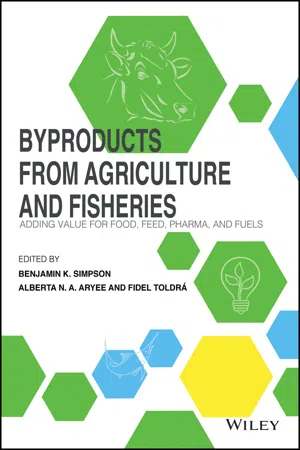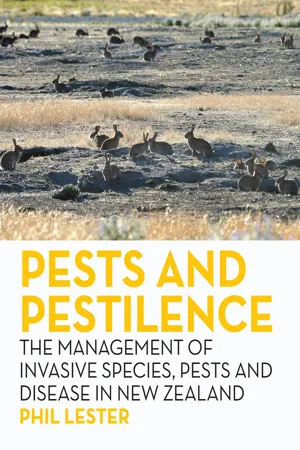Biological Sciences
Types of Pesticides
Pesticides are chemicals used to control pests and increase crop yield. They can be categorized into three main types: herbicides (targeting weeds), insecticides (targeting insects), and fungicides (targeting fungi). Each type of pesticide has specific modes of action and targets, and their use requires careful consideration of potential environmental and health impacts.
Written by Perlego with AI-assistance
Related key terms
Related key terms
1 of 4
Related key terms
1 of 3
10 Key excerpts on "Types of Pesticides"
- eBook - ePub
Environmental Forensics
Contaminant Specific Guide
- Robert D. Morrison, Brian L. Murphy(Authors)
- 2010(Publication Date)
- Academic Press(Publisher)
8Pesticides
Randy D. Horsak, Philip B. Bedient, M. Coreen Hamilton and F. Ben ThomasPublisher Summary
The purpose of this chapter is to provide a brief overview of the Types of Pesticides, their fate in their environment, analytical considerations and forensic techniques available to age date and identify the source of the pesticide release into the environment. A pesticide is defined as a chemical agent used to destroy or control pests. The generic term pesticides can apply to a wide spectrum of chemicals, including insecticides, rodenticides, herbicides, fungicides, biocides, and similar chemicals. Pesticides are extensively investigated and their chemical properties, toxicological properties, and fate and transport are well known. Pesticides may be categorized according to a number of parameters, including chemical structure, route of exposure, and method of application. Pesticides include herbicides, insecticides, fungicides, rodenticides, fumigants, and other categories. Typically, the most widely used pesticides in commercial applications are insecticides, herbicides, and fungicides, while more rodenticides and botanicals are used in domestic applications.Contents8.1. INTRODUCTION8.2. Types of Pesticides8.3. PHYSICAL AND CHEMICAL PROPERTIES8.4. ANALYTICAL TESTING8.5. FORENSIC TECHNIQUES8.6. CASE STUDIESREFERENCES8.1 INTRODUCTION
A pesticide is defined as a chemical agent used to destroy or control pests. The root word is the Latin word “cida” which means to kill. The generic term “pesticides” can apply to a wide spectrum of chemicals, including insecticides, rodenticides, herbicides, fungicides, biocides, and similar chemicals.Pesticides have been extensively investigated since the 1960s, and their chemical properties, toxicological properties, and fate and transport are well known. The purpose of this chapter is to provide a brief overview of the Types of Pesticides, their fate in their environment, analytical considerations and forensic techniques available to age date and identify the source of the pesticide release into the environment. - eBook - ePub
Emerging Pollutants
Origin, Structure, and Properties
- Francisco G. Calvo-Flores, Joaquin Isac-Garcia, Jose A. Dobado, Joaquín Isac-García, José A. Dobado(Authors)
- 2017(Publication Date)
- Wiley-VCH(Publisher)
Chapter 7 Pesticides as Pollutants7.1 Introduction
The term “–cide” has its origin in Latin, meaning “to kill.” The EPA defines pesticides as any substance or a mixture of substances intended for preventing, destroying, repelling, or mitigating any pest.1Many Types of Pesticides are effective against specific pests such as insects, parasites, fungi, weeds, rodents, and so on. Pesticides are used in agriculture related to crop growth, storage, and transport; in food marketing; in wood and wood products in industries; in livestock for the control of insects, arachnids, and other pests; in gardening; and in household maintenance. These chemicals play a key economic role and serve human health by killing vectors of many diseases. Pesticides in agriculture are rarely used in pure or technical-grade form. The active component that acts against pests/plant diseases is termed “active substance” and, mixed with other components, constitutes the pesticide formulation. These ingredients are often called as “inert,” although the term is potentially misleading, and they serve a variety of functions, for example, to stabilize active components or to provide a better application to improve absorption by plants. Most are synthetic organic compounds but in recent years a new group of pesticides have become an effective tool for pest control, the so-called biopesticides. The EU considers biopesticides as “a form of pesticide based on microorganisms or natural products” and the EPA defined biopesticides as naturally occurring substances that control pests (biochemical pesticides), microorganisms that control pests (microbial pesticides), and pesticidal substances produced by plants containing added genetic material. The International Union of Pure and Applied Chemistry (IUPAC) has adopted the same criteria for biopesticides as EPA.2The EU has compiled a database for active substances according to Regulation (EC) No 1107/2009 [1],3 which is periodically updated. Concurrently, EPA has developed its own database for pesticides with similar information.4 - eBook - ePub
Environmental Pollution Impact on Plants
Survival Strategies under Challenging Conditions
- Tariq Aftab, Khalid Rehman Hakeem, Tariq Aftab, Khalid Rehman Hakeem(Authors)
- 2023(Publication Date)
- Apple Academic Press(Publisher)
Pesticides are chemical compounds used to kill pests, such as insects, rodents, fungus, and weeds (unwanted plants). More than 1000 Types of Pesticides (insecticides, herbicides, and fungicides) are used to kill pests all over the world. Pesticides are a necessary component of human life since they are used to prevent the growth of undesirable organisms in crop areas. According to studies, just 0.1% of pesticides reach the target pest and the remaining amount of the pesticides is absorbed by the surrounding environment. In fact, there are two aspects to evaluate the application of pesticides. The first one is to evaluate the risk assessment (hazards) and the second one is the economic and agriculture benefits. Pesticides, despite their advantages, may be harmful to both humans and the environment. Therefore, in this chapter, the author aims to provide a scientifically based assessment of the benefits and hazards of pesticides used in human life.___________________ Environmental Pollution Impact on Plants: Survival Strategies under Challenging Conditions. Tariq Aftab, PhD & Khalid Rehman Hakeem, PhD (Eds.) © 2023 Apple Academic Press, Inc. Co-published with CRC Press (Taylor & Francis)2.1 Introduction
2.1.1 Pesticides
Pesticides are chemical compounds used to kill, prevent, repel any pests, for example, insects, rodents, plant pathogens, molluscs, birds, mammals, fungi, and unwanted plants (weeds).73 More than 1000 Types of Pesticides (insecticides, herbicides, and fungicides) are used to kill pests globally.Pesticides are chemicals that are used to prevent, kill, repel, or minimize pests, such as insects, animals, and plants, as well as microorganisms.—Grube et al.105According to Food and Agriculture Organization,83A pesticide is any substance or mixture of substances intended for preventing, destroying or controlling any pest, including vectors of human or animal disease, unwanted species of plants or animals, causing harm during or otherwise interfering with the production, processing, storage, transport, or marketing of food, agricultural commodities, wood and wood products or animal feedstuffs, or substances that may be administered to animals for the control of insects, arachnids, or other pests in or on their bodies.In general, pesticides should be toxic to the pests that are being targeted, but not to nontarget species, including human beings. It is said to say that this is not the case. A major debate about pesticide usage and abuse has erupted recently. The uncontrolled applications of these pesticides, under the proverb, “if little is good, a lot more will be better” has developed chaos in human and other life forms.Chronic pesticide risk has been enhanced by applying modern technology. In the 1950s, tiny amounts of pesticides could be detected at one part per million (ppm). Scientists discovered a trace quantity of pesticide in one part per billion (ppb) by 1965. By 1975, part per trillion (ppt) was used to detect the traces of pesticides, and presently we are using one part per quadrillion (ppq) or picograms per liter (pg/L) for detection. After decades of the use of pesticides in the United States, it is found that pesticide residues are present almost everywhere. Pesticide residues found in our food, air, or water may be quantified using advanced detection technology. Knowing the importance of sensitive pesticides residue detection abilities, the maximum allowable residue levels have been established by the EPA, which is called “tolerances.” The presence of pesticide residues according to the EPA’s range of “acceptable” risks is permissible in food commodities. The EPA has gone to extra mile to make the tolerances conventional. Pesticide usage in India is drastically different from that in the rest of the globe. It can be presented in Figure 2.1 . In India, 76% of insecticide is used as a pesticide while it is 44% globally.154 - eBook - ePub
- Mohd Imran Ahamed, Rajender Boddula, Tariq Altalhi, Mohd Imran Ahamed, Rajender Boddula, Tariq A. Altalhi(Authors)
- 2021(Publication Date)
- Wiley-Scrivener(Publisher)
However, it was observed that 75% of those who responded bought pesticides from agricultural chemicals factories. In total, 25.7% of the 74 farmers were noticed to sprinkle pesticides on the farmlands with full safety kits, while 66.7% of the farmers, whose pesticides got finished, abandoned the materials of spraying on their farmlands or dispose them in nearby bushes. It was also observed that the rate of application of the pesticides was subjected by the size of the farmland and the inexpensive nature of the chemicals. In conclusion, the farmers recommend the training of stakeholders and farmers on how to apply and handle pesticides as well the proportion to use depending on the intensity of the pest invasion or rebound. 13.3 Modes of Action of Pesticides Pesticides are well known for their recalcitrant and persistence nature in the ecosystem. The biotransformation ability of pesticides enables them to remain in living and non-living things in the environment. Lushchak et al. [39], in a review, looked at the mechanism of action of the toxic nature of pesticides. The authors classified pesticides based on their pathophysiological impacts, physical nature, use, sources, and their intrinsic nature. The impact of these environmental xenobiotics can be deciphered based on their molecular actions. Pesticides such as insecticides, fungicides, and herbicides have specific modes of actions when applied to crops. They stated that insecticides are known for their influence on energy production, development and growth of plants, and impact the muscles and nerves of humans. Fungicides are strictly inhibitors of mitochondrodrial-respiration activities, protein site synthesis, and ergo-sterol synthesis, whereas herbicides are basically regulators disrupters of pigment synthesis, cell membrane, lipid and amino acid synthesis, and growth and development of seeds and roots of plants - Ravindra Soni, Deep Chandra Suyal, Ajar Nath Yadav, Reeta Goel(Authors)
- 2022(Publication Date)
- Academic Press(Publisher)
Samada and Tambunan, 2020 ). The FAO defined biopesticides as biocontrol agents (BCAs) constituted of plant products, semiochemicals (pheromones), organisms that include predators, parasites, and some species of entomo-pathogenic nematodes, as well as their secondary metabolites. Initially, these BCAs were difficult to amplify to a larger amount and hence were used in smaller volumes.22.5: Sources and types of biopesticides
The major sources of biopesticides mostly constitute plants and microorganisms, which are rich in bioactive and antimicrobial compounds (Nefzi et al., 2016 ) that include phenols, alcohols, alkaloids, steroids, quinones, saponins, and terpenes (Mizubuti et al., 2007 ). They can be classified naturally or based on their sources, as seen in Fig. 22.2 .Fig. 22.2 Classification of biopesticides.22.5.1: Biochemical pesticides
The biochemical pesticides could comprise plant extracts that lure insects or insect-derived pheromones that hamper mating processes. Mostly found naturally, their environmentally nonharmful approach while targeting the pest organism (and usually being species-specific) is how they differ from the conventionally used chemical pesticides (Ritter Stephen, 2009 ; Chandler et al., 2011 ). The active component can contain a single or mixture of molecules of plant essential oils (EOs) or a mixture of isomers like that of insect pheromones. Noticeably, the most active component of biochemical pesticides are found naturally; however, their synthetic analogues may be used in the development of marketable products, often to facilitate the product and/or process workability, such as with insect pheromones.22.5.1.1: Plant extracts and oils
The botanical pesticides are plant-originating and mostly constituted from their EOs or other plant extracts. It’s been an ancient practice by traditionally using naturally available plant extracts as botanical pesticides for varying agricultural pest control, such as safeguarding both the crop cultivation and its storage from insect pests. Neem, cotton, pyrethrum, and tobacco are some of the most common sources of botanical pesticides and have been found to be effective against several diverse sucking and chewing insect pests (Lengai and Muthomi, 2018 ) (Table 22.1 ). These plants can function as a part of the functioning ecosystem without adversity. Varied antifungal, antibacterial, and antiviral properties have been identified in several botanical agents that can be used as substitutes for chemicals for the regulation of crop diseases (Pretali et al., 2016 ). Those botanical pesticides that are chemically synthesized closely resemble the natural plant derivatives and hence are easily degradable by soil-borne microbes, maintaining the biodiversity of predators, animal, and human health by reducing pollution (Grainge and Ahmed, 1988 ). They contain several active ingredients in reduced concentrations for initiating biocidal properties against different pathogenic and/or pest populations (Kalaycioglu et al., 1997 ; Harish et al., 2008- eBook - ePub
Green Processes, Volume 9
Designing Safer Chemicals
- Paul T. Anastas(Author)
- 2014(Publication Date)
- Wiley-VCH(Publisher)
Numerous substances are produced by plants, animals, and microorganisms to protect themselves from predators, locate sources of food, suppress or avoid competition, locate mates for breeding, and respond to changes in environmental conditions. Efforts to understand the biochemical interactions of organisms with one another and with the environment have led entrepreneurial researchers to identify, isolate, and in many instances synthesize these substances in the laboratory. In the furtherance of our understanding of natural chemical communication and microbial ecology, some discovered that many of these substances and microorganisms could be manipulated to mitigate the effects of pests. These naturally occurring substances, their synthetic analogs, and biocontrol microorganisms are defined by the USEPA as biopesticides. With the exception of microorganisms, biopesticides do not include any other biocontrol organisms, such as predatory insects.Most biopesticides are already present in the environment and are not persistent due to rapid biodegradation or dissipation by abiotic and biotic pathways. Biopesticides are distinguished from the synthetic conventional chemical pesticides by their unique modes of action, typically low application rates, and high specificity for target pests. Three major categories of biopesticide active ingredients are recognized by the USEPA: biochemicals, microbials, and plant-incorporated protectants (PIPs).Biochemical pesticides include all naturally occurring substances (or their structurally similar synthetic analogs) that are intended for use as attractants, repellents, desiccants, semiochemicals, plant and insect regulators, and induced systemic response (ISR) and systemic acquired response (SAR) inducers.Microbial pesticides include any microorganism that can be used as a pesticide, as defined by the Federal Insecticide, Fungicide, and Rodenticide Act (FIFRA) [28]. Biopesticide microorganisms include, but are not limited to, protozoa, algae, fungi, bacteria, and viruses.PIPs are pesticidal substances produced by plants and the genetic material necessary for the plant to produce the substance. After the genetic material is inserted through bioengineering, the transformed plant typically produces a pesticidal protein that controls the target pest. Both the protein and its genetic material are regulated by the USEPA; the genetically transformed plant itself is not regulated [29]. - B. D. Kaushik, Deepak Kumar, Md. Shamim, B. D. Kaushik, Deepak Kumar, Md. Shamim(Authors)
- 2019(Publication Date)
- Apple Academic Press(Publisher)
Bacillus thuringiensis , Bt). Also, there are few plant products which can now be used as a major biopesticide source (Salma et al., 2011). Plants naturally on genetic modification produce substances that act as plant-incorporated protectants. Such examples are the incorporation of Bt gene, protease inhibitor, lectines, chitinase, etc., into the plant genome so that the transgenic plant synthesizes its own substance that destroys the target pest. The use of bacterial biopesticides is considerable in agriculture and public health programs and has potential advantage.2.3 What are Biopesticides?
Biopesticides are particular type of pesticides derived from natural materials as animals, plants, bacteria, and certain minerals. For example, canola oil and baking soda have pesticidal properties and are considered biopesticides. In 2014, 430 registered biopesticide active ingredients and 1320 active Product registrations were identified. Biopesticides fall into three major classes:-
The active component of microbial pesticides consists of microorganism (e.g., a bacterium, fungus, virus, or protozoan). Microbial pesticides can control several kinds of pests, although each have separate active ingredient which is relatively specific for its target pest (Desai, 1997). For example, there are fungi that control certain weeds, and other fungi that kill specific insects (Desai, 1997). Subspecies and strains of Bt are the most extensively used microbial pesticides. Each strain of this bacterium produces a different mix of proteins, which specifically kills one or a few related species of insect larvae. Although some Bt’s control moth larvae found on plants, other are specific for larvae of flies and mosquitoes. The target insect species are determined by whether the particular Bt produces a protein that can bind to a larval gut receptor, thereby causing the insect larvae to starve (Kalra and Khanuja, 2007).
- eBook - ePub
Byproducts from Agriculture and Fisheries
Adding Value for Food, Feed, Pharma and Fuels
- Benjamin K. Simpson, Alberta N. Aryee, Fidel Toldrá, Benjamin K. Simpson, Alberta N. Aryee, Fidel Toldrá(Authors)
- 2019(Publication Date)
- Wiley(Publisher)
It also minimizes the dependence on synthetic chemical pesticides and fertilizers, which are widely used in conventional agricultural systems throughout the world. In modern agriculture, where it seems difficult to achieve potential and stable yield, and to maintain soil natural productivity simultaneously, the twin approach of biopesticide and biofertilizer applications, have produced remarkable results. These include sustainable crop productivity, increased yield, and improved overall soil bio‐physicochemical conditions. Hence, biopesticides and biofertilizers are invaluable concepts in integrated pest management (IPM), integrated nutrient management and nutrient cycling processes. Biopesticide is a modern crop protection tool used to reduce crop damage or crop yield loss from weed, insects, diseases, and nematodes. These chapter will closely look at the various types of biopesticides and biofertilizers, their general production methods, mechanism of action and utilization in agriculture and benefits. 20.2 What is Biopesticides? The term biopesticides defines compounds that are used to manage agricultural pests by mechanisms that involve specific biological effects rather than being used as broader chemical pesticides. These bioproducts contain biocontrol agents i.e. natural organisms or substances derived from natural materials such as animals, plants, bacteria, or certain minerals including their genes or metabolites specially formulated for use as a safe and effective pest controlling product. The United States Environmental Protection Agency (EPA) describes biopesticides as a broad term that includes naturally occurring substances that control pest (biochemical pesticide), microorganisms that control pests (microbial pesticides) and pesticidal substances produced by plants containing added genetic material. The added genetic materials are referred to as plant‐incorporated protectant s (PIP s) - eBook - ePub
Pests and Pestilence
The Management of Invasive Species, Pests and Disease in New Zealand
- Phil Lester(Author)
- 2023(Publication Date)
- Te Herenga Waka University Press(Publisher)
8 This pesticide definition includes biopesticides. Organisations such as the United States Environmental Protection Authority label biopesticides as naturally occurring substances that control pests (biochemical pesticides), microorganisms that control pests (microbial pesticides), and pesticidal substances that are produced by plants to which humans have added genetic material (plant-incorporated protectants). Wikipedia tells us that in 2006 and 2007, the world used approximately 2.4 megatonnes of pesticides. Herbicides constituted the biggest contributor to world pesticide use at 40%, followed by insecticides (17%) and fungicides (10%). The remainder includes rodenticides, molluscicides, virucides and chemicals, such as 1080, for controlling mammalian pests.The first recorded use of pesticide was 4500 years ago in ancient Mesopotamia, where sulphur was employed for the control of mites and insects attacking food. The Romans used sulphur in an attempt to kill ants and weeds in the 1st century BCE; the Chinese used arsenic to control insect pests in their crops and orchards in 800 CE. Over time, this developed into the use of metal compounds as pesticides, with the invention of ‘Paris green’ (a combination of copper acetate and arsenic trioxide) in 1814. By the 1880s, Paris green was the first globally widespread chemical pesticide. It was used to kill mosquitoes and tobacco budworm, and acquired its name when used to kill rats in Parisian sewers.Another of the earliest widely used pesticides was DDT (Dichloro-diphenyl-trichloroethane). DDT is an organochlorine pesticide, first synthesised in 1874. Its insecticidal properties were discovered in 1939, and it was first used during World War II to combat malaria, typhus and lice among civilians and troops. Subsequently it was employed all over the world as an agricultural and household pesticide. It was heavily used for pest control on a wide variety of crops and played a substantial role in combating mosquito-borne disease. Largely because of the availability of DDT and the drug chloroquine, in 1955 the WHO launched the Global Malaria Eradication Programme with major effect. For example, the occurrence of malaria in Sri Lanka plummeted from an estimated 2.8 million cases in 1946 to just 17 cases in 1966.9 - eBook - ePub
Organic Farming
Global Perspectives and Methods
- Sarath Chandran, Unni M.R., Sabu Thomas, Sarath Chandran, Unni M.R., Sabu Thomas(Authors)
- 2018(Publication Date)
- Woodhead Publishing(Publisher)
3.3 Pest Control Methods
Unbalanced agricultural systems usually generate pest and disease problems. Therefore, optimizing the management system, including measures to ensure healthier crops, or to create less favorable conditions for pests and diseases, is the major challenge in organic farming (Wyss et al., 2005 ; Eilenberg and Hokkanen, 2007 ; Forster et al., 2013 ; Barzman et al., 2015 ). Thus, the crop protection strategy adopted—integrated pest management—relies on a combination of “indirect, or preventive, crop protection ” methods. And, if this approach is insufficient, organic farmers may resort to “direct, or curative, crop protection ” methods—with priority given to consideration of biological and biotechnical methods, and where the use of natural plant protection products (biopesticides) is restricted to a minimum (Peshin and Pimentel, 2014 ).Several control methods can be used against pests and diseases, such as regulatory (regulatory measures to control and reduce the dissemination of insects and pathogens), genetic (plant breeding or selection of varieties that are resistant to specific pests and diseases), cultural (cultural practices that alter the environment, the condition of the host, or the behavior of the pest or disease), physical (use of devices, machines, or other physical methods to control pests), biological (use of natural enemies of pests—beneficial insects and disease-causing organisms—and encouraging their development), and biotechnical (use of insect physiological mechanisms or environmental behaviors, that will negatively affect their survival). When none of the previous methods are available for a specific pest or disease, the use of pesticides that are naturally derived (biopesticides) might be an option.
Index pages curate the most relevant extracts from our library of academic textbooks. They’ve been created using an in-house natural language model (NLM), each adding context and meaning to key research topics.
Explore more topic indexes
Explore more topic indexes
1 of 6
Explore more topic indexes
1 of 4
